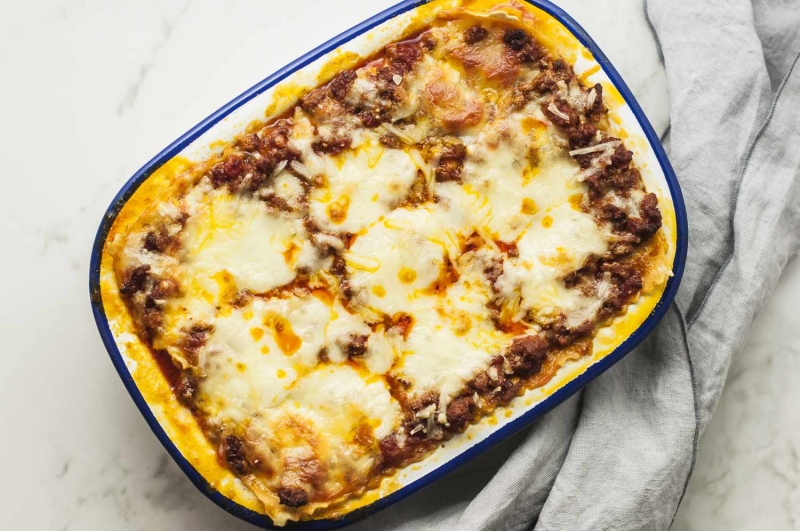We Settle This Debate Once and For All
One of the reasons there are so many opinions on the best ways to freeze lasagna is that lasagna freezes really well. You almost can’t mess it up. But is there a best way to freeze and bake a frozen lasagna? Is it best to bake before freezing, then rebake or freeze first, bake later? Should you thaw it first or cook it from frozen? Read on for the answers to these and more questions.
Bake First or Freeze First?
Perhaps the biggest question is you should to bake the lasagna before freezing. While lasagna freezes really well, baking, freezing, thawing, and rebaking inevitably takes a toll on the quality of the ingredients.
Admittedly, one of the great things about lasagna is that it freezes so well. A baked, frozen, then re-baked lasagna will still be good. But it’s at the margins where quality is affected. That crunchy, caramelized crust that appears on top of a baked lasagna is arguably one of its most appealing qualities. Unfortunately, when you bake, freeze, and then rebake it, that crust won’t be fresh, brand new, and sizzling the way it will if it’s only been frozen, then baked once.
When you cook something, you alter it fundamentally. The proteins, fats, starches, and sugars all change in one way or another. Starches like pasta absorb liquid. Proteins denature, fats liquefy, and sugars caramelize.
These components change again when they're frozen. The water in the pasta crystallizes, altering the texture of the pasta. Baking a lasagna twice also means heating up the liquids in the sauce twice, leading to evaporation, possibly drying it out, as well as potentially overcooking the pasta. Dairy products can separate when frozen and thawed (to say nothing of cooking them twice).
The ways in which food quality can suffer when subjected to all these changes are innumerable. And even though a lasagna is incredibly forgiving of all this, it's still best to only bake it once.
Let's also think about the intent. If you're making this lasagna for your own household, this might not be as important. But a lasagna is a perfect dish to prepare as a gift for someone who has just had a baby, getting over an illness, or is grieving. And as such, giving someone a baked, then frozen lasagna is like giving them leftovers. Whereas giving them an unbaked lasagna is giving them a fresh meal. Their effort—baking it—is the same, but the result is much different.
Building the Lasagna
If you're making the lasagna knowing that you're going to freeze it, there are a few things you might do differently than if you're simply making a lasagna to bake right away, starting with your choice of noodles.
And if you're planning to freeze your unbaked lasagna, no-boil noodles are a must. Yes, you can boil regular lasagna noodles, then drain and cool them and build your lasagna, then freeze it. But this is a lot of extra work and due to the long cooking times required to cook a frozen lasagna, they will most likely end up mushy.
On the other hand, no-boil lasagna noodles are basically made to be frozen. You simply layer in the dry noodles along with your other ingredients. As a matter of fact, they're much easier and more convenient to use than regular noodles even if you aren't freezing your lasagna. But when preparing lasagna for the freezer, they're a must. (Note: Sheets of fresh pasta will also work well.)
As for whether to use a ricotta or cottage cheese filling versus a plain béchamel, a béchamel might survive the freezing process marginally better than ricotta or cottage cheese, but as long as you’re only baking it once, the ricotta or cottage cheese will be just fine.
The same goes for the question of whether a vegetarian lasagna will hold up better than one with meat. As long as your freezer is at 0 F or colder, you shouldn’t have a problem—again, as long as the lasagna is only baked once.
Freezing the Lasagna
You can freeze your lasagna in a foil pan, tightly covered with foil, or even right in the baking dish, provided the dish is safe for both freezer and oven. But if you don't want your baking dish in the freezer for months where you can't use it for anything else, you can always line the dish with heavy foil, build the lasagna, then fold the foil over the top and freeze.
Once the lasagna is frozen, you can lift it out of the dish, leave the foil-wrapped lasagna in the freezer, thus freeing up your baking dish. When you're ready to bake, just set the frozen lasagna, still in its foil, back in the dish and bake.
Cooking a Frozen Lasagna
When baking a frozen lasagna, you face the choice of whether to thaw it first or bake it directly from its frozen state. And while it does take longer to bake a frozen lasagna than a fresh or thawed one, thawing a frozen lasagna requires defrosting it in the fridge at least overnight, possibly up to 24 hours. Which means that it's overall much quicker to bake a frozen lasagna.
Firstly, remember to preheat your oven. Next, as a rule, baking a frozen lasagna requires doubling the baking time. So if the original recipe called for baking for 45 minutes at 400 F, go for 90 minutes at 400 F. And be sure to keep the foil tightly sealed until the last 15 minutes of cooking, then uncover it so that the cheese has a chance to brown. Keeping the foil sealed is particularly essential when using no-boil noodles, since it's the built-up steam from the sauce that cooks them.


